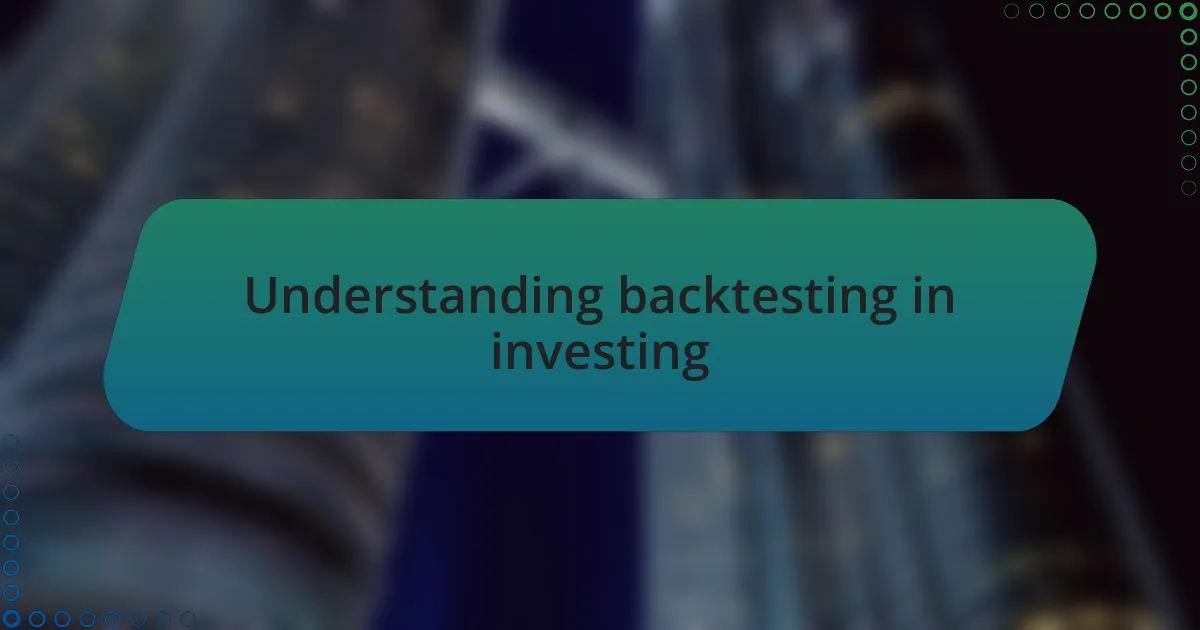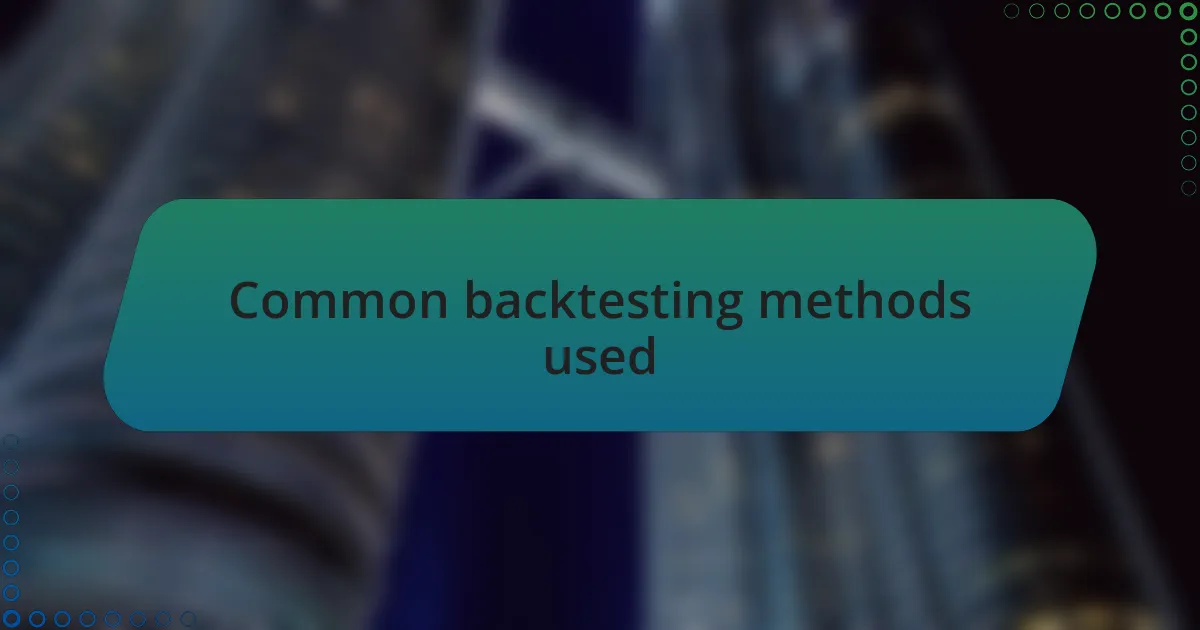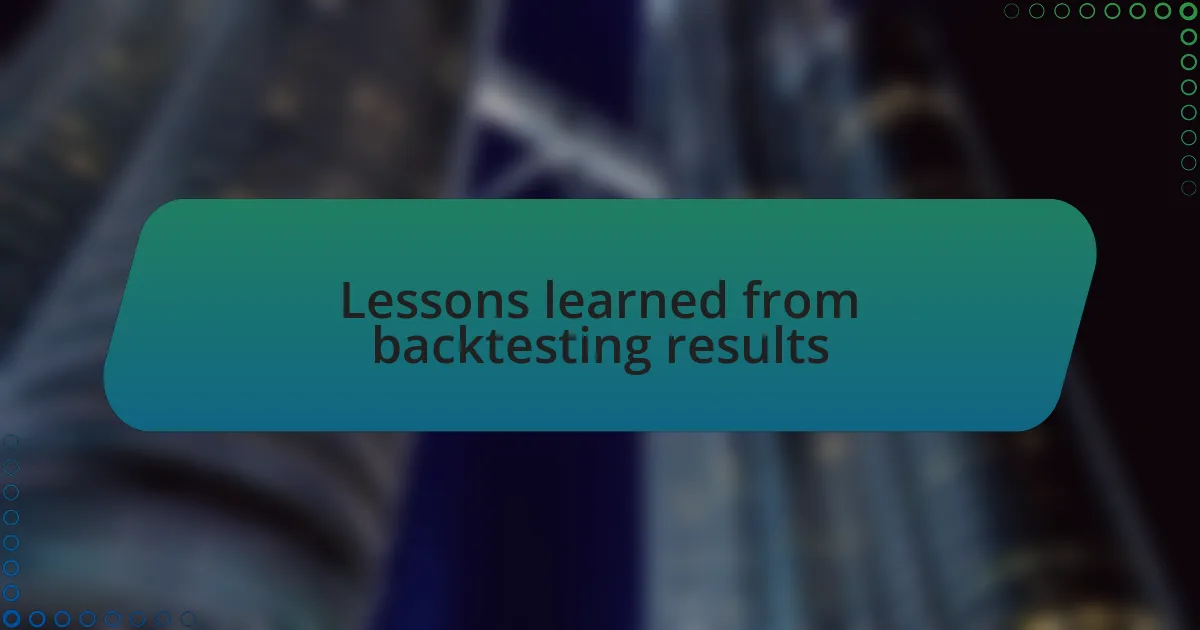Key takeaways:
- Backtesting is essential for assessing trading strategies but cannot predict unforeseen market events.
- Emotional biases can cloud decision-making; backtesting reveals the need for discipline and data-driven approaches.
- Data quality and thorough evaluation are crucial, as inaccuracies can lead to misleading results.
- Understanding market conditions and being open to simpler strategies can enhance overall trading success.

Understanding backtesting in investing
Backtesting is a process that allows investors to assess the viability of a trading strategy using historical data. It’s like opening a window into the past to see how a strategy would have performed under various market conditions. Does it really reflect future potential? I often ponder this while analyzing my past trades, realizing that while backtesting provides valuable insights, it can’t account for unforeseen market events that might change the game entirely.
As I dive into my own strategies, the thrill of seeing successful trades in backtesting can be exhilarating, but it also comes with a warning. I’ve made the mistake of becoming overly confident in strategies that performed well historically, only to face disappointing results in live markets. This emotional rollercoaster reminds me that while backtesting is a useful tool, it’s essential to remain humble and constantly adapt to changing market dynamics.
The technical side of backtesting, including proper data handling and accounting for transaction costs, can be daunting. I’ve learned the hard way that neglecting these factors skews the results I’m so eager to analyze. Have you ever experienced that uncomfortable feeling when reality doesn’t match your expectations? Balancing the excitement of past performance with a grounded, realistic approach is crucial for any investor looking to refine their strategies.

The importance of backtesting
The importance of backtesting cannot be overstated. In my early days of trading, I remember the thrill of testing a strategy and seeing impressive results. However, I learned that these numbers are just one piece of the puzzle. They provide a foundation, but only if combined with an understanding of market nuances. Without backtesting, I would have been flying blind, relying solely on gut feelings that can often mislead us.
One aspect that really struck me was how backtesting highlights specific weaknesses within a strategy. I once had a setup that seemed perfect at first glance. But when I ran the numbers, I realized it faltered during volatile periods. This discovery was pivotal; it gave me the opportunity to tweak my approach before risking real capital. Have you ever caught a flaw in your plan just in the nick of time? Those “aha” moments can save not just money, but also your mental well-being.
Ultimately, backtesting serves as a crucial risk management tool. It distances me from emotional decision-making by providing a clear, data-driven perspective. I still recall a time I was convinced to enter a trade based purely on a hunch. When I compared that decision against my backtested strategies, I understood the importance of staying disciplined. Have you ever felt the pull of emotion clouding your judgment? This is where backtesting becomes invaluable—it reinforces the necessity of sticking to a plan, no matter how enticing a new idea might seem.

Common backtesting methods used
When it comes to backtesting, one of the most common methods I often rely on is the historical simulation. This approach takes past data—price movements, volumes, and other relevant factors—and runs a strategy as if the market were live. I vividly remember a scenario where applying historical simulation revealed that my strategy performed well during a bullish market but dramatically underperformed when the tides turned. Have you ever noticed such discrepancies in your testing? It’s those insights that truly highlight the importance of understanding different market conditions.
Another widely used method is Walk-Forward Optimization. I often find this approach fascinating because it allows me to refine my strategy continuously. By testing a model on a portion of historical data and then optimizing it for the next segment, I’ve been able to adapt my strategies in real-time. This dynamic process turned out to be a game-changer during a particularly turbulent period in the market. Does your strategy feel rigid? If it does, Walk-Forward Optimization might just be the tool to add flexibility and responsiveness to your trading.
A simpler yet effective method I sometimes lean towards is the Monte Carlo simulation. This technique introduces randomness to test how a strategy might perform under various scenarios. I recall a time when I applied this method, and it helped me understand the range of possible outcomes for my trades. It was like lifting the fog of uncertainty. Have you taken enough time to explore the broader possibilities of your trading approach? Monte Carlo simulations opened my eyes to not just the expected returns but also the risks associated with my strategies.

Personal insights from my backtesting
When I delved into backtesting, one of the most eye-opening realizations was how emotional biases often cloud decision-making. I vividly remember running simulations where my initial gut feelings led to poor performance, only for the cold calculations of the backtest to reveal a clearer path. Have you ever let fear or greed dictate your trades? Recognizing these biases through backtesting became a key turning point for me.
The importance of data quality also struck me profoundly. One memorable instance involved testing a strategy, only to discover that the data set used contained inaccuracies—like an unexpected limitation in historical price points. This oversight led to an underwhelming strategy performance that solidified my belief in diligent data vetting. Have you ever stopped to scrutinize your data sources? It’s a step that can save you from costly misjudgments.
Lastly, I found that backtesting illuminated the significance of patience. Early on, I felt pressured to implement strategies quickly without thorough testing, which often resulted in frustrating losses. However, after embracing a more methodical approach in my backtesting, I learned that allowing sufficient time for evaluation often translated into stronger, more reliable strategies. How often do you rush your processes? Taking the time to backtest properly has not only improved my success rates but also made the trading journey much more rewarding.

Lessons learned from backtesting results
When analyzing backtesting results, I learned that expectations can shape outcomes in surprising ways. In one instance, I expected a particular strategy to outperform based on my research. However, the results showed it underperformed compared to a simpler approach I had dismissed. Have you ever put your hopes into a complicated strategy only to realize the basics might’ve sufficed? This experience taught me to remain open-minded and not let preconceived notions limit my exploration.
Another lesson that hit home was the value of consistency. I once tested two variations of the same strategy—one with frequent adjustments and one with a set rule. While the first was tempting to follow due to its perceived sophistication, the rule-based version consistently performed better over time. It made me ponder: Are we sometimes too eager to tinker instead of trusting proven methods? This reinforced the idea that sticking to a plan can often yield better results than chasing fleeting trends.
I also discovered the vital role of market conditions when interpreting backtesting results. Early in my journey, I neglected to account for varying market environments, leading to overconfidence in a strategy that worked well in a bull market but failed during downturns. Have you ever trusted a strategy without considering the broader market context? This awakening underscored how crucial it is to calibrate expectations based on changing market conditions, encouraging a more nuanced and adaptable approach to investing.

Practical applications of backtesting findings
When I applied my backtesting findings, I noticed a significant improvement in my decision-making process. For instance, after evaluating the performance of a momentum strategy, I found that it thrived during certain periods but faltered during market corrections. Reflecting on this, I realized the importance of timing and now integrate these insights into my current portfolio adjustments. Have you ever changed your strategy based on historical data?
Additionally, the application of robust risk management emerged clearly through my testing. One experiment, where I tracked a losing strategy over time, highlighted the power of setting strict loss limits. I learned that while embracing potential gains is crucial, safeguarding against heavy losses often dictates long-term success. How often do we overlook this simple yet effective principle when caught up in the chase for profit?
Moreover, I’ve come to appreciate the importance of periodic reviews of my strategies based on backtesting results. Initially, I tended to stick with my approaches a bit too long, even when the data suggested a change was warranted. Now, I frequently reassess performance metrics—perhaps you’ve felt the dread of watching a formerly successful strategy decline in effectiveness? This continuous evaluation process has instilled a discipline in my investing habits that fosters resilience and adaptability.